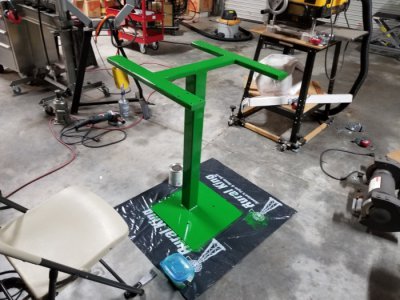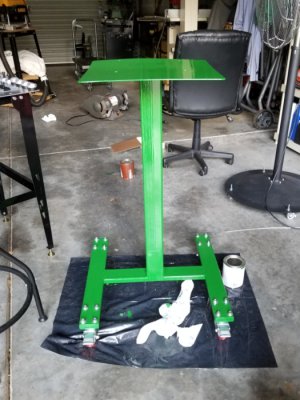- Joined
- Jun 15, 2017
- Messages
- 525
Greetings. I have not posted before, but I have some experience with other machining forums. I hope I can be a useful contributor here.
I am working on a mobile base for a bench grinder. I welded it together, and I've been painting it for what seems like forever. I tried to do it right instead of slapping a coat of Ebay-blue spray paint on it and letting the drips fall where they might. I used brush-on Rust-Oleum tractor paint because I knew it was very durable.
It has been quite an odyssey. I have been told a number of new things. For example, I've seen people saying it's a waste of time to prime under this paint. They say it wears like iron and sticks just fine with no primer, and that's distressing, because priming was a major pain in the butt.
I've also seen people saying the EPA is the reason I have brush marks. They say the EPA forced paint manufacturers to change their formulas to reduce volatile organic compounds. Supposedly, this causes paint to form a skin quickly, and that leads to brush marks even if you do everything right. I have been told the answer is to add a product called Penetrol, which, of course, adds volatile organic compounds and undoes the evil perpetrated by the EPA. I added some Penetrol to the paint, and it seemed to help, but I already had some paint on the project, so if Penetrol helps, it will only reduce the problem, not solve it.
I am wondering if anyone here knows the real answers.
What with the primer (white, so I have to use more coats to cover it), the brush marks, and the Penetrol, it's taking me an eternity to finish this job.
This base will be done in about two days, regardless, but I plan to make other projects in the near future, so it would be good to pick up useful information.
I am working on a mobile base for a bench grinder. I welded it together, and I've been painting it for what seems like forever. I tried to do it right instead of slapping a coat of Ebay-blue spray paint on it and letting the drips fall where they might. I used brush-on Rust-Oleum tractor paint because I knew it was very durable.
It has been quite an odyssey. I have been told a number of new things. For example, I've seen people saying it's a waste of time to prime under this paint. They say it wears like iron and sticks just fine with no primer, and that's distressing, because priming was a major pain in the butt.
I've also seen people saying the EPA is the reason I have brush marks. They say the EPA forced paint manufacturers to change their formulas to reduce volatile organic compounds. Supposedly, this causes paint to form a skin quickly, and that leads to brush marks even if you do everything right. I have been told the answer is to add a product called Penetrol, which, of course, adds volatile organic compounds and undoes the evil perpetrated by the EPA. I added some Penetrol to the paint, and it seemed to help, but I already had some paint on the project, so if Penetrol helps, it will only reduce the problem, not solve it.
I am wondering if anyone here knows the real answers.
What with the primer (white, so I have to use more coats to cover it), the brush marks, and the Penetrol, it's taking me an eternity to finish this job.
This base will be done in about two days, regardless, but I plan to make other projects in the near future, so it would be good to pick up useful information.

















